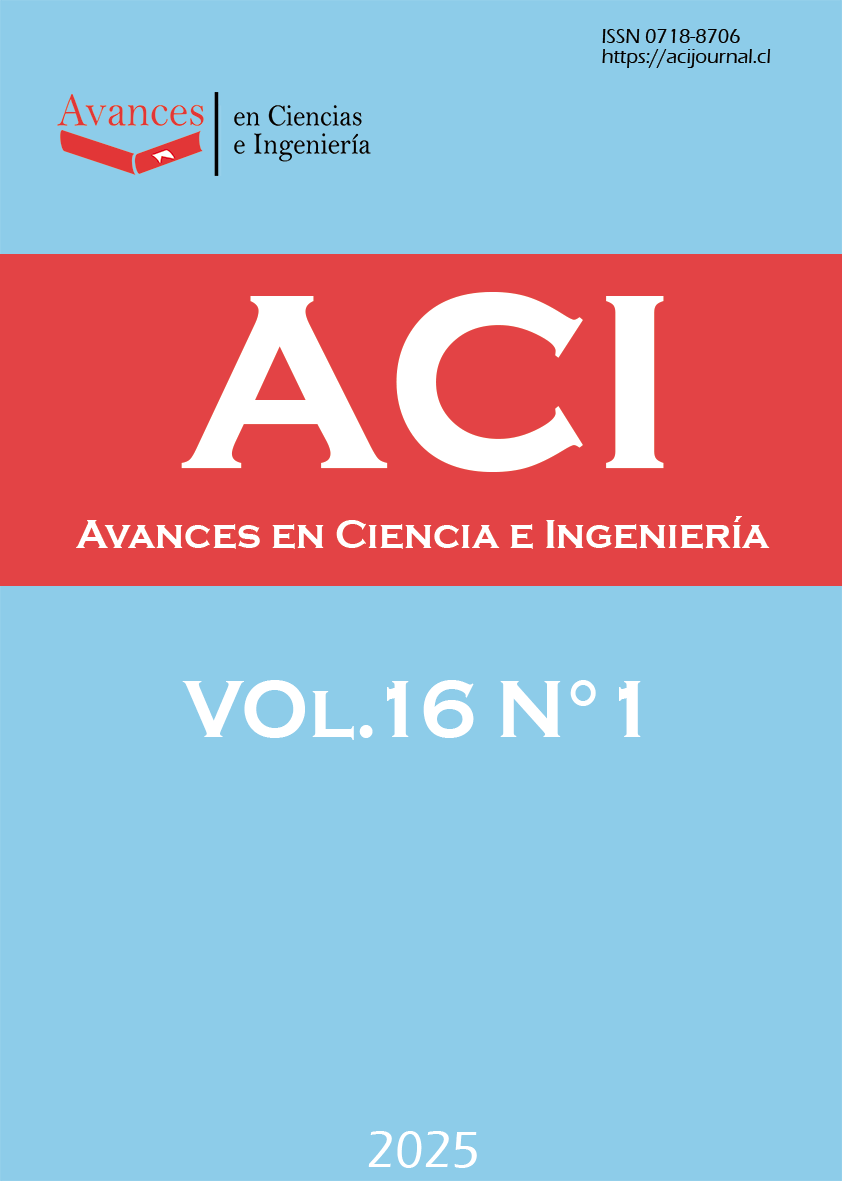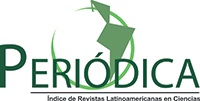Photocatalytic degradation of ibuprofen using TiO2/SiO2 catalyst prepared by sol-gel method
DOI:
https://doi.org/10.65093/aci.v16.n1.2025.24Keywords:
emerging contaminants, nanomaterials, solar light, advanced oxidation processesAbstract
TiO₂/SiO₂ nanomaterial was employed as catalyst for degradation of non-steroidal anti-inflammatory drug ibuprofen through a solar photocatalysis process. The catalyst was synthesized by the sol-gel method and characterized using different techniques. EDS analysis confirmed a Ti:Si atomic ratio close to the theoretical 1:3, while XRD revealed the presence of anatase phase in TiO₂ and the amorphous structure of SiO₂. SEM micrographs showed the catalyst morphology, and N₂ adsorption–desorption analysis revealed type IV isotherms, typical of mesoporous materials. Photocatalytic tests under 8 hours of solar irradiation demonstrated 80–85% ibuprofen degradation. UV-Vis spectra evidenced a decrease in aromatic ring absorbance at 220 nm and an increase in carboxylic acid absorbance at 280 nm during 4 hours of solar irradiation in the first day, indicating the formation of intermediate byproducts, which were eliminated by the end of the photocatalytic process during 4 hours of the second day. Besides, the apparent velocity rate constant (k = 0.0295 min⁻¹) and the adsorption constant (kads = 0.0797 L/mg) confirmed the efficiency of the nanomaterial, enhanced by the strong interaction with the catalyst.
Downloads
References
Ahmed, Y., Dutta, K.R., Akhtar, P., Hossen, M.A., Alam, M.J., Alharbi, O.A., et al. (2025). Emerging strategies in the sustainable removal of antibiotics using semiconductor-based photocatalysts. Beilstein Journal of Nanotechnology, 16, 264–285. https://doi.org/10.3762/bjnano.16.21
Alawi, M.A., Alahmad, W.R. & Al-Fogha'a, B.T. (2017). Photocatalytic degradation of diclofenac and ibuprofen by SiO₂/TiO₂/(Ru, N) catalysts under sun light in solar bath-like system. Fresenius Environmental Bulletin, 26 (5), 3685–3691.
Bedolla, R. & García-Rivero, M. (2011). Immobilization of Aspergillus niger sp. in sol gel and its potential for production of xylanases. Journal of Sol-Gel Science and Technology, 57 (1), 6–11. https://doi.org/10.1007/s10971-010-2314-6
Bellardita, M., Addamo, M., Di Paola, A., Marcì, G., Palmisano, L., Cassar, L., et al. (2010). Photocatalytic activity of TiO2/SiO2 systems. Journal of Hazardous Materials, 174 (1–3), 707–713. https://doi.org/10.1016/j.jhazmat.2009.09.108
Chaker, H., Fourmentin, S., & Chérif-Aouali, L. (2020). Efficient Photocatalytic Degradation of Ibuprofen under Visible Light Irradiation Using Silver and Cerium Co-Doped Mesoporous TiO₂. ChemistrySelect, 5 (38), 11787–11796. https://doi.org/10.1002/slct.202002730
Gauthier, J. M., Downing, J. A., & Sappington, K. G. (2019). Effects of pharmaceuticals in the environment: Ecotoxicology and regulatory frameworks. Environmental Toxicology and Chemistry, 38 (4), 812-821. https://doi.org/10.1002/etc.4412
Gil, J.M., Soto, M.A., Usma, I.J. & Gutierrez, D.O. (2012). Contaminantes emergentes en aguas, efectos y posibles tratamientos. Producción Más Limpia, 7 (22), 52–73. http://www.scielo.org.co/scielo.php?script=sci_arttext&pid=S1909-04552012000200005
Godawat, R., Ameta, R. & Kothari, S. (2016). A study on the effect of untreated and TiO2 treated Orange G solution on the growth and biochemical parameters of Allium cepa (onion). Department of Chemistry, PAHER University. Udaipur, India. https://www.tsijournals.com/articles/a-study-on-the-effect-of-untreated-and-tio2-treated-orange-g-solution-on-the-growth-and-biochemical-parameters-of-allium.pdf
Han, S., Choi, K., Kim, J., Ji, K., Kim, S., Ahn, B., et al. (2010). Endocrine disruption and consequences of chronic exposure to ibuprofen in Japanese medaka (Oryzias latipes) and freshwater cladocerans Daphnia magna and Moina macrocopa. Aquatic Toxicology, 98 (3), 256–264. https://doi.org/10.1016/j.aquatox.2010.02.013
Jiménez-Salcedo, M., Monge, M. & Tena, M.T. (2019). Photocatalytic degradation of ibuprofen in water using TiO2/UV and g-C3N4/visible light: Study of intermediate degradation products by liquid chromatography coupled to high-resolution mass spectrometry. Chemosphere, 215, 605-618. https://doi.org/10.1016/j.chemosphere.2018.10.053
Kadiyala, N., & Kumar, P. (2025). Ionic liquid mediated sol gel method for fabrication of TiO₂–SiO₂ nanocomposites with enhanced photocatalytic activity. ACS Omega, 10 (1), 1234–1242. https://doi.org/10.1021/acsomega.4c07743
Kobayashi, M., Kuma, R., Masaki, S. & Sugishima, N. (2005). TiO2–SiO2 and V2O5/TiO2–SiO2 catalyst: Physico-chemical characteristics and catalytic behavior in selective catalytic reduction of NO by NH3. Applied Catalysis B: Environmental, 60 (3–4), 173–179. https://doi.org/10.1016/j.apcatb.2005.02.030
Kumar, A. & Pal, D. (2018). Antibiotic resistance and wastewater: Correlation, impact and critical human health challenges. Journal of Environmental Chemical Engineering, 6, 52–58. https://doi.org/10.1016/j.jece.2017.11.059
Kumar, A., Khan, M., Zeng, X., & Lo, I. M. C. (2018). Development of g-C₃N₄/TiO₂/Fe₃O₄@SiO₂ heterojunction via sol-gel route: A magnetically recyclable direct contact Z-scheme nanophotocatalyst for enhanced photocatalytic removal of ibuprofen from real sewage. Journal of Hazardous Materials, 344, 1–12. https://doi.org/10.1016/j.jhazmat.2017.10.037
Laos Barrera, L.M. (2019). Reducción de la concentración de ibuprofeno en una muestra de agua sintética, mediante fotocatálisis heterogénea (Trabajo de suficiencia profesional). Universidad Nacional Tecnológica de Lima Sur. Recuperado de http://repositorio.untels.edu.pe/jspui/handle/123456789/211
Lin, L., Zhang, Y. & Wang, H. (2019). Adsorption and photocatalytic oxidation of ibuprofen using nanocomposites of TiO₂ nanofibers combined with BN nanosheets. Science of the Total Environment, 650, 132–141. https://doi.org/10.1016/j.scitotenv.2018.09.157
Marbán, G., Fernández-Pérez, A. & Álvarez-García, S. (2023). Ultraviolet light spectroscopic characterization of ibuprofen acid aggregation in deionized water. Heliyon, 9 (11), e21260. https://doi.org/10.1016/j.heliyon.2023.e21260
Masuda, R., Takahashi, W. & Ishii, M. (1990). Particle size distribution of spherical silica gel produced by sol-gel method. Journal of Non-Crystalline Solids, 121 (1–3), 389–393. https://doi.org/10.1016/0022-3093(90)90163-G
Matoh, L., Žener, B., Kovačić, M., Kušić, H., Arčon, I., Levstek, M., et al. (2022). Photocatalytic sol-gel/P25 TiO₂ coatings for water treatment: Degradation of 7 selected pharmaceuticals. Ceramics International, 49 (14), 24395–24406. https://doi.org/10.1016/j.ceramint.2022.09.204
Méndez-Arriaga, F., Maldonado, M. I., Giménez, J., Esplugas, S. & Malato, S. (2009). Abatement of ibuprofen by solar photocatalysis process: Enhancement and scale up. Catalysis Today, 144 (1–2), 112–116. https://doi.org/10.1016/j.cattod.2009.01.028
Merghes, P., Ilia, G., Maranescu, B., Varan, N. & Simulescu, V. (2024). The Sol–Gel Process, a green method used to obtain hybrid materials containing phosphorus and zirconium. Gels, 10 (10), 656. https://doi.org/10.3390/gels10100656
Migliore, L., Panzica, S., & Baldini, M. (2020). Bioaccumulation of pharmaceutical pollutants in aquatic organisms: Environmental risk assessment. Environmental Pollution, 264, 114720. https://doi.org/10.1016/j.envpol.2020.114720
Miranda, M.O., Cavalcanti, W.E.C., Barbosa, F.F., de Sousa, J.A., Silva, F.I., & Braga, T.P. (2021). Photocatalytic degradation of ibuprofen using titanium oxide: Insights into the mechanism and preferential attack of radicals. RSC Advances, 11(16), 9371–9380. https://doi.org/10.1039/D1RA04340D
Moreno Ortiz, V. C. (2013). Los medicamentos de receta de origen sintético y su impacto en el medio ambiente. Revista Mexicana de Ciencias Farmacéuticas, 44 (4), 17–29. https://www.scielo.org.mx/scielo.php?pid=S1870-01952013000400003&script=sci_abstract
Oliveira, M., Cabral, W.E., Fernandes, F., de Souza, J.A., da Silva, F.I., Pergher, S.B.C., et al. (2021). Photocatalytic degradation of ibuprofen using titanium oxide: Insights into the mechanism and preferential attack of radicals. RSC Advances, 11 (34), 20886–20897. https://doi.org/10.1039/D1RA04340D
Rashid, R., Shafiq, I., Gilani, M. R. H. S., Maaz, M., & Akhter, P. (2024). Advancements in TiO₂-based photocatalysis for environmental remediation: Strategies for enhancing visible-light-driven activity. Chemosphere, 349, 140703. https://doi.org/10.1016/j.chemosphere.2023.140703
Ruggeri, G., Ghigo, G., Maurino, V., Minero, C. & Vione, D. (2013). Photochemical transformation of ibuprofen into harmful 4-isobutylacetophenone: Pathways, kinetics, and significance for surface waters. Water Research, 47 (16), 6109–6121. https://doi.org/10.1016/j.watres.2013.07.031
Sá, A.S., Feitosa, R.P., Honório, L., Peña-Garcia, R., Almeida, L.C., Dias, J.S., et al. (2021). A brief photocatalytic study of ZnO containing cerium towards ibuprofen degradation. Materials, 14(19), 5891. https://doi.org/10.3390/ma14195891
Salcedo, M. J. (2021). Photocatalytic degradation of pharmaceuticals in water: Design of nanocatalysts and study of by-products and mechanism [Tesis de máster, Universidad de La Rioja]. Repositorio Institucional de la Universidad de La Rioja. https://investigacion.unirioja.es/documentos/6184c37d2b9f274a4b5b097d
Schaper, J.L., Posselt, M., McCallum, J.L., Banks, E.W., Hoehne, A., Meinikmann, K., et al. (2018). Hyporheic exchange controls fate of trace organic compounds in an urban stream. Environmental Science & Technology, 52 (20), 12285–12294. https://doi.org/10.1021/acs.est.8b03117
Trianda, Y., Adityosulindro, S. & Moersidik, S. S. (2024). Ibuprofen as an emerging contaminant of concern: Occurrence in Southeast Asia water environment. E3S Web of Conferences, 530, 02007. https://doi.org/10.1051/e3sconf/202453002007
Utomo, R.S.B. & Hidayat, T. (2024). TiO₂/SiO₂ nanocomposite via a novel sol-gel method. Materials Science in Semiconductor Processing, 145, 106556.
Wang, P., Bu, L., Wu, Y., Ma, W., Zhu, S. & Zhou, S. (2021). Mechanistic insight into the degradation of ibuprofen in UV/H2O2 process via a combined experimental and DFT study. Chemosphere, 267, 128883. https://doi.org/10.1016/j.chemosphere.2020.128883
Downloads
Published
How to Cite
Issue
Section
License

This work is licensed under a Creative Commons Attribution-NonCommercial-NoDerivatives 4.0 International License.









